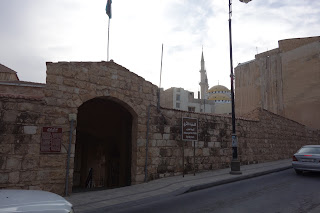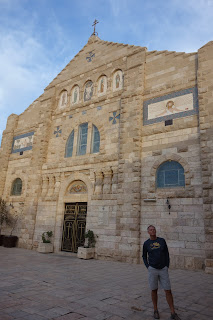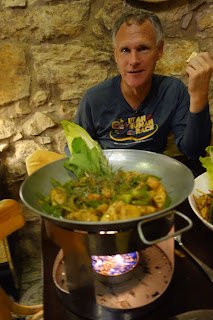

 \
\
The River Jordan is rather unimpressive and small. What was once a mighty river is no more than a drainage ditch. Decades of competition between Israel and Jordan for water have diverted more than 90% of it's water, providing Israel with one-third of it's water supply. Israel claims the baptismal site of Jesus to be on the west side of the river, where we saw tourists entering the river dressed in white.
Three additional modern-day churches of various faiths have been built near this UNESCO site. Excavation is in progress to unearth the remains of three ancient churches connected by a marble staircase which leads to the "John the Baptist Spring". The large photo below shows the believed location of Christ's baptism.
The photo below shows "Elijah's Hill", but we did not stop to walk across the viewing platform.
At mount Nebo, we were greeted by an interesting statue of Moses.
We visited the ruins of a Byzantine church and monastery first constructed in the second half of the 4th century to commemorate the place of Moses' death.
A "Brazen Serpent" stands here as a reminder of Moses' experiences leading the children of Israel through the wilderness (yes, wilderness!). From this vantage point of this mountain, on a clear day, one can see Jericho and Jerusalem.
Finally, Bob and I drove to the city of Madaba, which is known for it's mosaics. Madaba was established during the middle bronze age (2000 BC), and is a Moabite city mentioned in the Bible.
The city is most well known for the Madaba Mosaic Map which is preserved in the Greek Orthodox Basilica of Saint George. The map, made of 2 million pieces of colored stone, is a 6th century representation of Palestine and part of it contains the oldest surviving original cartographic depiction of the Holy Land and especially Jerusalem.
The receptionist suggested we visit the Church of St. John the Baptist which was located just a short walk down the road. In the church is a Shrine for the beheading of the Baptist, Acropolis rooms, ruins, and tunnels, a Moabite well, tent of Ruth, museum and models of 6th century Madaba, and a bell tower from which are fabulous views of the city.
We left the church with hungry stomachs, and found a cute restaurant where we enjoyed some traditional food including the Jordanian salad, Fattoush. a delicious meat and vegetable dish was brought to us on a warmer. We watched as the waiter at the table next to ours broke open a ceramic pot in which their meal had been cooked. Some of the spices are available only in the middle east, and I purchased those needed to make my own Fattoush.
Fully satisfied with our day, we drove back to the Jensen's home in Amman where we spent our last night in Jordan. I am completely awestruck when I consider that Bob and I walked where Jesus walked, stood where Moses stood, and wandered in the wilderness of Jordan as did the children of Israel! How grateful I am for these experiences. But more than being in this place, I am thankful for the life and ministry of our Savior, Jesus Christ, and the place He has in my heart every single day of my life!










































































No comments:
Post a Comment